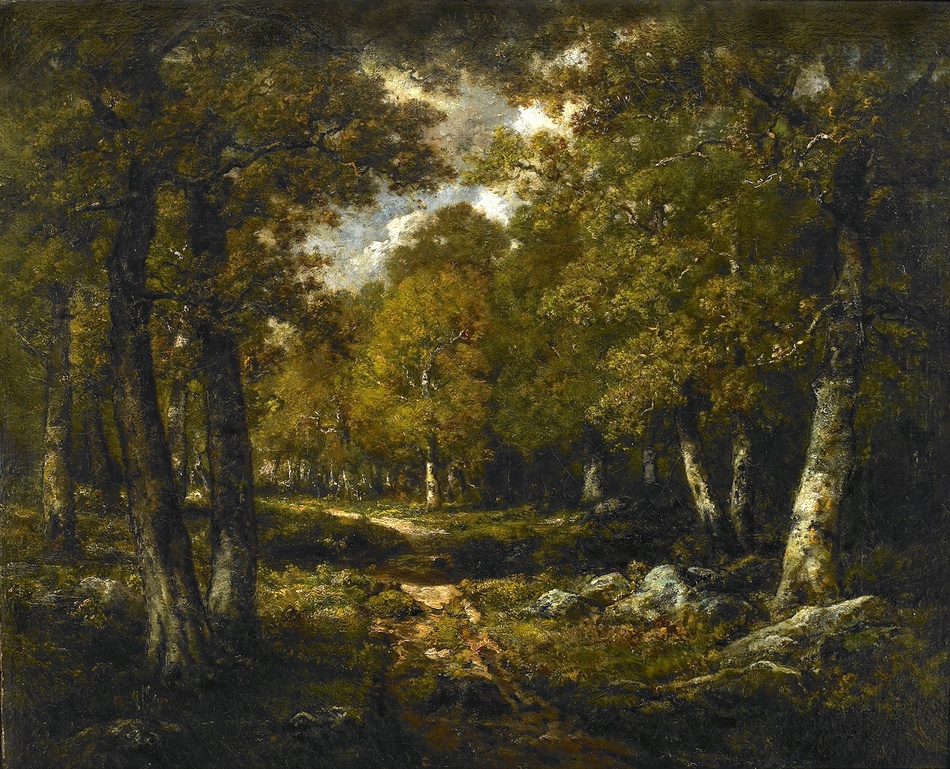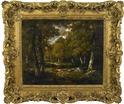Clearing in the Woods
Signed lower right: N Diaz
Provenance:
Charles Knox Smith, Philadelphia
Woodmere Art Museum, Philadelphia (sold to benefit the Charles Knox Smith Art Acquisition Fund)
To be included in the supplement to the Diaz de la Pena catalogue raisonné in preparation by Mme. Rolande Miquel.
The present work belonged to Charles Knox Smith (1845-1916) of Philadelphia. Smith made his fortune in the oil business and participated in the city politics of Philadelphia for over 20 years. In 1901, Smith moved into his newly renovated home in the historic Chestnut Hill section of Philadelphia. The Victorian mansion, originally built in the 1860's provided Smith with the space to actively pursue his avocation: the collection and celebration of art. He died in October, 1916 leaving in his will the following stipulation: "It is my will and desire that the said premises, 9201 Germantown Avenue, together with my collection of paintings, antique rugs, statuary, vases, and objects of art shall be converted into a public museum and gallery...for the use and benefit of the community in which I have lived..." The Smith house and collection became the Woodmere Art Museum. Clearing in the Woods remained in the Woodmere Museum collection until 2010, when it was sold to benefit the Museum Acquisition Fund.
Narcisse Virgile Diaz de la Pena was one of the foremost figures of the first generation of Barbizon artists. He, along with Rousseau, Millet, Daubigny, Corot, Dupré, Jacque and Troyon, established the Barbizon movement that drew hundreds of artists to the forest of Fontainebleau over the course of the nineteenth century. The heart of Barbizon art was direct study from nature, be it landscape or the human figure. Barbizon artists were the first to narrow the gap that had traditionally existed between the direct sketch and the finished studio picture.
Diaz was born to Spanish emigrant parents on August 20, 1807 in Bordeaux. At the young age of seventeen, Diaz went to work for a printer, then for a porcelain manufacturer, where he met the young Jules Dupré and Nicolas-Louis Cabat, both of whom would also later work at Fontainebleau Forest, as well as the painter Auguste Raffet. Immersed in this group, Diaz honed his skill at the higher arts with a few lessons from François Souchon (1787-1857) and by copying at the Louvre. The works of artists such as Pierre Paul Prud?hon and Correggio inspired him, and, following this vein, his early paintings of the 1830s were romantic visions of nymphs, bathers, or Oriental women in lush, wooded settings. These catered to the popular taste for 18th century style Rococo and resulted in financial success for the young artist.
Though figure painting would always remain important for Diaz, it is his landscapes of the 1850s, 60s, and 70s, particularly those of Fontainebleau Forest, for which the artist is most remembered. Diaz met Theodore Rousseau in 1837 and showed his first Fontainebleau landscape at the Salon of that year. He began to exhibit pure landscapes without figures only after 1848, and the success of these forest interior scenes, including one which won him a first class medal at the Salon of 1848, allowed him to discontinue exhibiting publicly at the Salon after 1859. Recognized as a superb colorist in his own day, his forest interiors are richly painted with warm browns, oranges, golds and silvery tree trunks and branches. Though the artist often applied paint loosely with a broad palette knife, his acute observation of nature and natural effects was nevertheless keen. He was officially decorated even after leaving the official exhibition system when he received the Legion d?honneur in 1881. Diaz?s financial success enabled him to lend a helping hand to his friends when in need, including Troyon, Rousseau, and Millet.
The artist died at Menton on November 18, 1876. Phillippe Burty, a well-respected critic and supporter of the Barbizon school wrote in his eulogy of the artist,
"The Forest of Fontainebleau loses in Diaz an artist who had the truest perception of its peculiar charm. He did not see it in its somber grandeur; he felt its delight and fascination. No one has so successfully caught the spirit of the pleasure parties that crowd its shady alleys in spring time and summer. No one has renderedwith such astonishing effect the bright flashes of slanting sunlight upon the trunks of its beeches and birch trees. No one, again, has translated with such force and brilliancy the velvet surface of its moss-grown rocks or the embrowned gold of its autumn foliage."1
- Philippe Burty, quoted in J. Comyns Carr, Art in Provincial France: Letters written during the summer of 1882 to the Manchester Guardian (London: Remington and Co., 1883): p. 74
Selected Museum Collections:
Rijksmuseum and Municipal Museum, Amsterdam; Walters Art Museum, Baltimore; Musée départemental de l?Oise, Beauvais; Musée des Beaux-Arts de Béziers; Museum of Fine Arts, Boston; Musée des Beaux-Arts de Caen; Fitzwilliam Museum, Cambridge, UK; Musée Condé, Chantilly; Art Institute of Chicago; Musée d?Art et d?Histoire, Cholet; Cleveland Muesum of Art; Musée national du château, Compiègne; Detroit Intsitute of Arts; Musée Magnin, Dijon; National Gallery of Scotland, Edinburgh; Musée de Grenoble; National Gallery of Finland, Helsinki; Mesdag Museum, The Hague; Courtauld Institute of Art, Wallace Collection, Victoria and Albert Collection and National Gallery, London; Los Angeles County Museum of Art; Musée Grobet-Labadié and Musée des Beaux-Arts, Marseille; National Gallery of Victoria, Melbourne; Minneapolis Institute of Art; Tretiakoff Museum, Moscow; Musée des Beaux-Arts de Nantes; Metropolitan Museum of Art, New York; Petit Palais, Musée d?Orsay and Musée du Louvre, Paris; Norton Simon Museum, Pasadena; Philadelphia Museum of Art; Musée des Beaux-Arts de Rouen; Hermitage Museum, Saint Petersburg; Fine Arts Museums of San Francisco; Musée des Augustins, Toulouse; Musée des Beaux-Arts de Troyes; National Gallery of Art, Washington DC;
Request more information
News on the artist
-
The Clark has an exhibition of British & French landscapes, including #Barbizon painters #Rousseau, #Dupré, and #Troyon. http://t.co/JEEym3mJuly 27, 2011 @ 2:40 PM UTC
-
Now in Glasgow: #Millet #Barbizon Pastel of "The Angelus" Allocated to Kelvingrove Art Gallery and Museum: http://t.co/soF2LMA via @AddThisAugust 1, 2011 @ 3:35 PM UTC
-
See the great-grandfather of French landscape painting @AshmoleanMuseum: http://t.co/3KFFPXqu #Barbizon #exhibitionsOctober 6, 2011 @ 3:00 PM UTC
-
National Gallery of Art to reopen 19th-century French galleries in January: http://t.co/2HcCfSuF #Academic #PostImpressionist #BarbizonOctober 20, 2011 @ 9:17 PM UTC
-
Masterpieces from the Musée d'Orsay on view in Asia: http://t.co/xNhXdBgT #Realism #Barbizon #Academic #Impressionism #exhibitionsNovember 1, 2011 @ 3:38 PM UTC
-
Take a photo tour of @MuseeOrsay new Impressionist galleries: http://t.co/gmVlnx5n @artinfodotcom #Academic #Impressionism #BarbizonNovember 3, 2011 @ 4:34 PM UTC
-
Städel Museum to open Claude #Lorraine exhibition in February 2012: http://t.co/rA5Z1eTr via @AddThis #exhibitionsIwishIcouldsee #BarbizonDecember 12, 2011 @ 10:53 PM UTC
-
When you visit the new 19th-century galleries @ngadc don't miss this #Rousseau http://t.co/Qgr6EWp5 and http://t.co/awPyBEDl #BarbizonJanuary 30, 2012 @ 10:42 PM UTC
-
http://t.co/xkAzAOwi - Would #Renoir be the same had he not met #DiazdelaPena in #Barbizon in 1862 and come under his influence?February 7, 2012 @ 10:14 PM UTC
-
March 16, 2012 @ 7:56 PM UTC
-
Google expands Art Project to 150+ #museums http://t.co/SFjJl9UI Here is an early #Corot @philamuseum http://t.co/M6AuUwof #BarbizonApril 10, 2012 @ 2:50 PM UTC
-
Paradises & Landscapes in the Thyssen Coll. opens in Málaga: http://t.co/bS54sQ4n #Barbizon #PostImpressionist #Impressionism #exhibitionsApril 10, 2012 @ 3:09 PM UTC
-
April 13, 2012 @ 9:22 PM UTC
-
Happy Birthday Jules #Dupre April 15, 1811 (same day as Theordore #Rousseau!) http://t.co/Vq4MBTrD #BarbizonApril 13, 2012 @ 9:23 PM UTC
-
Baroness Carmen Thyssen Bornemisza to sell "The Lock" by John #Constable at Christie's: http://t.co/qdMksw47 #Academic #BarbizonMay 30, 2012 @ 7:40 PM UTC
-
Shame that this is leaving the @museothyssen - Protest in Spain at sale of #Constable 's 'The Lock' http://t.co/xFY0yAKn #museums #BarbizonJuly 2, 2012 @ 4:03 PM UTC
-
July 16, 2012 @ 8:01 PM UTC
-
August 29, 2012 @ 10:26 PM UTC
-
#Courbet 's Majestic Oak Painting Returns to Its Roots After Hometown Museum's $5-Million Purchase http://t.co/y2JTiZXo #Barbizon #RealismSeptember 7, 2012 @ 3:07 PM UTC
-
Musee d'Orsay opens major show of 19th-cty paintings at new Shanghai museum http://t.co/DE9KXjtE #Barbizon #Naturalism #CourbetNovember 19, 2012 @ 10:19 PM UTC
-
French #Romantic, #Realist, #Barbizon and #Impressionist drawings on view at National Gallery of Art, Washington http://t.co/lxq8IPwUJanuary 28, 2013 @ 11:44 PM UTC
-
February 14, 2013 @ 4:00 PM UTC
-
#Courbet 's Modernity - lecture by Jack Flam at the NY Studio School tomorrow! http://t.co/OPWboSvmWK #Barbizon #RealismMarch 12, 2013 @ 3:27 PM UTC
-
Jacquemart-André Museum in Paris opens exhibition devoted to Eugène #Boudin http://t.co/FUAqaF7MGn #Barbizon #exhibitionsIwishIcouldseeMarch 21, 2013 @ 2:55 PM UTC
-
Tim Marlow on TEFAF's Treasures on Sotheby's Blog includes #Constable #Delacroix #Gericault http://t.co/Z82FXz1Lul #Barbizon #RomanticismMarch 22, 2013 @ 9:14 PM UTC
-
Happy belated bday Theodore #Rousseau http://t.co/7UrhiBahm6 and Jules #Dupre http://t.co/ATFe97j3cs. Apr 15 -a great day for #Barbizon artApril 16, 2013 @ 4:05 PM UTC
-
June 10, 2013 @ 3:41 PM UTC
-
Now at Schiller & Bodo : MASTERWORKS OF THE BARBIZON SCHOOL, on view through November 27 http://t.co/pgDhaUAscc #Barbizon #exhibitionsNovember 5, 2013 @ 4:10 PM UTC
-
April 15, 2014 @ 5:33 PM UTC
-
And Happy Birthday Jules #Dupre - April 15, 1811 - a great day for #Barbizon School painters! http://t.co/62PKvhJpN8April 15, 2014 @ 7:03 PM UTC
-
Take a look at this #Diaz from the 1904 #WorldsFair at the @kemperartmuseum in St. Louis. http://t.co/n2h0vSI9Fw #BarbizonMay 1, 2014 @ 3:35 PM UTC
-
Here is our current #exhibition catalogue: A Romantic Vision, The #Barbizon School and its Contemporaries http://t.co/iemkJ4fmdGMay 5, 2015 @ 5:16 PM UTC
-
300 years of French landscape painting at the Toledo Museum of Art, including #Rousseau #Courbet #Daubigny http://t.co/j21mPIWRc4 #BarbizonAugust 11, 2015 @ 2:52 PM UTC
-
Take a look at our new catalogue of gallery acquisitions: https://t.co/1oOYwViYZK #Lhermitte #DiazdelaPena #Dore #Guillaumin #Loir #PicabiaJanuary 14, 2016 @ 5:52 PM UTC
-
#Daubigny, Monet, Van Gogh: Impressions of Landscape is open now at the Taft Museum of Art- https://t.co/8BlaBpUD0P #Barbizon #ImpressionismMarch 10, 2016 @ 5:50 PM UTC
-
Rediscovering #Daubigny , an Unsung Influence on the Impressionists https://t.co/nPa7zTFG4d #Impressionism #BarbizonMarch 15, 2016 @ 3:01 PM UTC
-
Happy Birthday Théodore #Rousseau , born April 15, 1812 : https://t.co/lJZexdfYUU #Barbizon #artistbirthdaysApril 15, 2016 @ 7:09 PM UTC
-
Opening Monday- Unruly Nature: The Landscapes of Théodore #Rousseau @ the Getty https://t.co/L9tATSW4sX #Barbizon #exhibitionsIwishIcouldseeJune 17, 2016 @ 8:23 PM UTC
-
Théodore #Rousseau Gets His Due at the Getty Museum https://t.co/MLe45ku6oS #Barbizon #exhibitionsIwishiIcouldseeJuly 15, 2016 @ 7:30 PM UTC
-
Opening at the @vangoghmuseum : #VanGogh #Rousseau #Corot: In the Forest : https://t.co/NSNvTW3bV5 #Barbizon #exhibitionsIwhiIcouldseeJuly 13, 2017 @ 9:49 PM UTC
-
Happy Birthday to Jean Francois #Millet, one of the original great #Barbizon painters, whose work has moved its aud… https://t.co/w7kqh3CTZZOctober 4, 2018 @ 5:43 PM UTC




